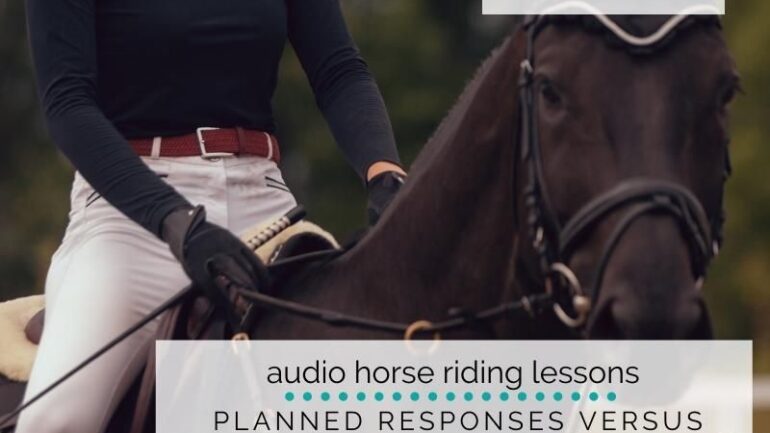Do you have days where, after you get home, sit down, and think over the day’s events, you think to yourself “Why did I react like that?!”? I know I do, even now. I find that if I allow my emotions to run things, the chances of everything turning out exactly as I would have two chances. Slim and none! This is why I began, a few years ago now, creating planned responses in my riding.
Simply put, I began thinking about what ‘could’ or ‘might’ happen… And how the ‘best version’ of me would respond in the moment to the situation.
Being able to think about what I would like any outcome to be and then plan, in advance, the best response to achieve this changed everything. It meant that I didn’t have to necessarily change ‘me’, I can still have the same emotional response. However, I also know what actions I want to take in order to deal with the situation.
Make a List of Planned Responses
I began by creating a list of things that, when they did happen, often ‘triggered’ me to react differently than I would have liked at the moment. For riders, this list might include things like ‘my horse begins to act up and dance around’. Or it may be something like ‘my horse begins to gain speed and momentum in the canter’.
Literally, begin by thinking about a few ‘unpleasant’ things you have already experienced with your horse, or you have seen other people experience, that did not turn out well.
I think that it is important to include things that are not actually caused by or related to your horse. Like the wind, or other horses’ behavior. Other considerations might include being on the ground… I had a little person years ago that seemed to have a knack for putting her toes under the pony’s hooves! Ouch! While she initially would scream, shout (all understandably enough), and carry on, pinned under the pony and waiting for help, we began to change that.
Approaching the topic at times when she was relaxed and calm, I would ask her what she thinks she could do to have a better outcome…
Now, obviously, keeping her toes out of the way of the hooves was top of the list ;). However, we also discussed the possibility that, even with the most cautious of intentions, the pony did the unthinkable and stepped on her feet.
And that was key to her beginning to choose better responses – approaching the topic when everyone was calm and relaxed.
Letting Your ‘Best Self’ Guide You
For most of us, when we find ourselves knee-deep in a situation we don’t feel comfortable with, self-awareness can seem difficult to practice! This is why I strongly suggest thinking about all of these things BEFORE they happen. Create planned responses. Obviously, you cannot account for everything.
Start with your most recent or memorable (usually for the wrong reasons) experiences. What do you wish you had done differently in the moment. Then, figure out why…
Begin thinking about a ‘best case scenario’ if that were to happen again. Or if you could ‘do-over’ that day. What could you have changed about how you prepared, or how you responded, that might have changed the outcome? Even if that change was just that you felt better afterward.
Thinking about someone whom you know would have successfully handled the situation and noticing the actions they took may help if you’re feeling stuck.
The key is to do this when you are feeling good, calm, and focused. See this as an investment in your future self. You are ‘safe proofing’ your responses in stressful situations going forward. Allow the calm, level-headed version of you to lead the way with regards to how you would like to respond next time around.
Responding Versus Reacting
Once you have a clearer vision for how you would like to respond, the trick becomes putting that into action! Easier said than done! I find that one of the best ways to do this is to begin to notice as soon as possible when you choose a different response to the one you wanted. Initially, this may only happen after the fact. However, the more you practice this, the better you will become at self-awareness.
I find that I can begin to move the awareness closer to the actual event that triggered me each time. Until eventually, I have awareness at the moment of the event – and can choose a different response.
Even if you are seconds or minutes into your usual reaction, when you do notice yourself – change your actions immediately. Begin your ‘planned response’ instead.
The more consistent you can become with this in your riding, the better you can show up as a rider. And, from there, the more consistent you can be with your responses on a day-to-day basis.
Having consistency in your planned responses, and them being in alignment with your vision of yourself as a rider, builds confidence.
It will build your own confidence in your own abilities. But also, your horse’s confidence in your abilities as well. That will, over time, deepen the partnership. And maybe, you will find yourself in space someday soon, where you no longer need your ‘planned responses’…
Happy Riding
Lorna
-
-
- Reacting Versus Responding in Your Riding
- How Your Stories are Influencing Your Horse Riding
- 5 Actions to Your ‘Better Person’ in Your Riding
- Riding and Acting – The Relationship Between Them
- Your Mindset; What Do You Believe About Your Riding
- Connection; My Online Membership for Equestrians
- Online community for equestrians working on their mindset & fitness
- Online Community for equestrians focusing on re-schooling horses (and ex-racehorses
-

